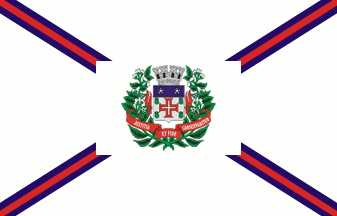 image by Dirk Schönberger,
9 October 2012
image by Dirk Schönberger,
9 October 2012Source: http://pt.wikipedia.org/wiki/Cajamar

Last modified: 2012-12-09 by ian macdonald
Keywords: sao paulo | cajamar |
Links: FOTW homepage |
search |
disclaimer and copyright |
write us |
mirrors
 image by Dirk Schönberger,
9 October 2012
image by Dirk Schönberger,
9 October 2012
Source:
http://pt.wikipedia.org/wiki/Cajamar
A white flag with a narrow red saltire, bordered blue, with the municipal arms in the centre on a white rectangle.
Official website at
http://www.cajamar.sp.gov.br
Dirk Schönberger,
9 October 2012
Cajamar originates in the establishment in the 1920s of cement works by the Companhia Brasileira de Cimento Portland. The factory, established in Perus, close to the Santos-Jundiaí, used stones from the Água Fria quarries. The cement workers and the miners settled in the 1930s the district of Água Fria. In the 1940s, a Federal Law forbidding the use of the same name by two municipalities caused the change of the district name to Cajamar - there was already a district of Água Fria in the municipality of São Paulo. The first settlement, built near the Pires quarry, was subsequently demolished and replaced by Vila do Acampamento and, eventually,Vila Nova. The Federal government regulated cement prize; which prompted the Canadian-funded company to sell the plant to José João Abdalla in 1951. Nationalized in 1974, the factory was acquired in the 1980s by a consortium of companies, while pollution caused by the factory caused increased concern by grassroot movements and government bodies.
The coat of arms, flag and anthem are prescribed as the municipal
symbols, to be adopted by a separate Law, in Article 3 of the
Municipal Constitution, last amended 13 September 2006.
http://www.camaracajamar.sp.gov.br/portal/leiorganica.html -
Municipal Constitution
The flag is white with a red saltire fimbriated blue. In the middle is placed a white rectangle charged with the municipal coat of arms.
Photos of the flag
http://pedalarmaquinadotempo.blogspot.fr/2010/05/voltei.html
http://www.cajamar.sp.gov.br/v2/?exibe=premios&canal=texto&id=1447
http://www.cajamar.sp.gov.br/v2/?exibe=juridico&canal=texto&id=1320
The coat of arms of Cajamar is "a Samnitic shield, argent a Cross of the Order of Christ cantoned with four 'araças'* vert spotted sable [spots not shown on the drawing], a chief azure charged with two stars or [argent on the drawing]. The shield surmounted by a four-towered mural crown argent ports sable. The shield supported by two branches of 'araçazeiros'* flowered and fructed proper [no fruit shown on the drawing]. Below the shield a scroll gules inscribed with the motto 'JUSTITIA ET FIDE CONSERVABITUR' argent."
The Samnitic shield is the traditional style of Brazilian municipal
coat of arms.
Argent represents the loyalty and frankness of the inhabitants.
The Cross of the Order of Christ is the symbol of the Portuguese
colonists and of the São Paulo pioneers, who used the same cross on
their flags; accordingly, the cross recalls that Cajamar belonged to
the Municipality of São Paulo.
The four 'araças' represent a fruit once abundant in the municipality
and makes the arms canting, from "cai", "spotty"; "a", "fruit"; and
"mar", "coloured, painted".
The blue chief represents the idealism of the inhabitants; blue is the
dominant colour of the arms of the municipality of Parnaíba, to which
Cajamar belonged.
The two stars represents the State and Federal powers.
The mural crown is a symbol of municipal sovereignty.
The motto means "Sticking to Faith and Justice".
http://www.cajamar.sp.gov.br/v2/?exibe=cidade&canal=brasao -
Municipal website
*'araça' is the generic name of different fruits cognate to guiava,
produced by trees of genus Psidium. The fruit of Psidium
guineense Sw. (synonym, Psidium araca Raddi) is known as Brazilian
guava our wild guava.
http://www.hort.purdue.edu/newcrop/morton/brazilian_guava_ars.html
Ivan Sache, 4 November 2012